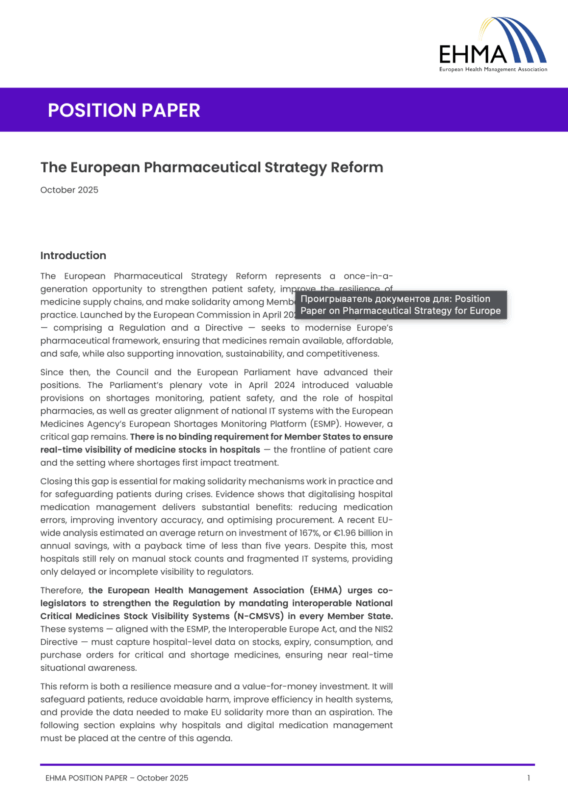Eleonora Varntoumian, Policy Manager at EHMA (European Health Management Association), shared a post on LinkedIn:
“Trilogues on the EU Pharmaceutical Strategy are entering a decisive phase.
As trilogues on the EU Pharmaceutical Strategy move forward, co-legislators have a real opportunity to address persistent structural gaps in the Regulation and Directive. EHMA’s latest position paper outlines targeted amendments to make the reform operational, future-proof, and aligned with wider EU digital and resilience strategies.
1. Hospital stock visibility
Introduce a legal obligation for National Critical Medicines Stock Visibility Systems in every Member State. These systems should collect near real-time data at the hospital level on: on-hand quantities by presentation and lot, expiry dates, consumption and purchase orders, and location granularity (hospital, pharmacy, ward).
- Amendments 262, 266, 272 – ensure interoperability with the European Shortages Monitoring Platform (ESMP) and other Union systems under Regulation (EU) 2022/123, using common technical specifications.
2. Medication errors and patient safety
Strengthen pharmacovigilance provisions so that medication errors are systematically reported, monitored, and addressed.
- Amendment 223 (Regulation, Art. 101) expands the definition of adverse reactions to include errors.
- Amendments 223, 232-233 (Directive, Arts. 97, 106–107) ensure reporting of errors in use, administration, and dispensation through Eudravigilance and national authorities.
3. Interoperability and legal alignment
The reform must align with the Interoperable Europe Act, the NIS2 Directive, and the Critical Medicines Act to avoid fragmented reporting and ensure cybersecurity by design.
- Amendment 223 (Directive) calls for the progressive adoption of digital dispensing, barcode scanning, and automated stock monitoring in hospital and retail pharmacies.
4. Addressing shortages systematically
Hospitals and ambulatory care settings must be legally recognized as key actors in shortage reporting and mitigation, not just downstream recipients.
- Recital 137 and Amendments 121-129 recognize shortages as a systemic risk.
5. Governance, funding, and accountability
The position paper calls for clear roles for EMA, MSSG, and national competent authorities, backed by:
- EU and national funding (RRF, EU4Health, Digital Europe)
- Common datasets and standards aligned with ESMP
- Defined KPIs on reporting timeliness, data completeness, error rates, and stock-out duration
Why this matters
- Public health resilience – anticipate and mitigate crises through real-time visibility.
- Efficiency – EU-wide analysis shows 167% ROI and €1.96 billion in annual savings from hospital digitalization.
- Legal coherence – ensure the pharmaceutical framework supports, rather than lags, wider EU digital and resilience policies.
Read the full position paper here.”

More posts featuring Eleonora Varntoumian on OncoDaily.
